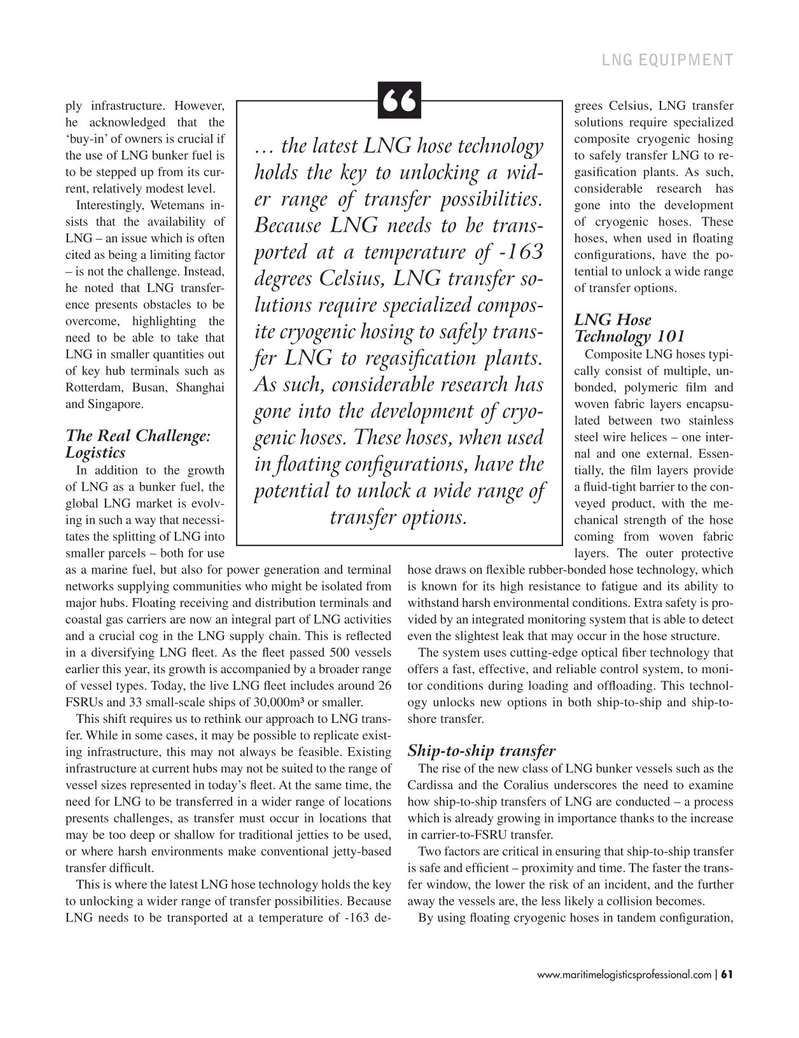
Page 61: of Maritime Logistics Professional Magazine (Nov/Dec 2017)
GREEN PORTS
Read this page in Pdf, Flash or Html5 edition of Nov/Dec 2017 Maritime Logistics Professional Magazine
LNG EQUIPMENT ply infrastructure. However, grees Celsius, LNG transfer he acknowledged that the solutions require specialized ‘buy-in’ of owners is crucial if composite cryogenic hosing … the latest LNG hose technology the use of LNG bunker fuel is to safely transfer LNG to re- to be stepped up from its cur- gasifcation plants. As such, holds the key to unlocking a wid- rent, relatively modest level. considerable research has er range of transfer possibilities.
Interestingly, Wetemans in- gone into the development sists that the availability of of cryogenic hoses. These
Because LNG needs to be trans-
LNG – an issue which is often hoses, when used in foating ported at a temperature of -163 cited as being a limiting factor confgurations, have the po- – is not the challenge. Instead, tential to unlock a wide range degrees Celsius, LNG transfer so- he noted that LNG transfer- of transfer options.
ence presents obstacles to be lutions require specialized compos- overcome, highlighting the LNG Hose ite cryogenic hosing to safely trans- need to be able to take that Technology 101
LNG in smaller quantities out Composite LNG hoses typi- fer LNG to regasifcation plants. of key hub terminals such as cally consist of multiple, un-
As such, considerable research has
Rotterdam, Busan, Shanghai bonded, polymeric flm and and Singapore. woven fabric layers encapsu- gone into the development of cryo- lated between two stainless
The Real Challenge: steel wire helices – one inter- genic hoses. These hoses, when used nal and one external. Essen-
Logistics in foating confgurations, have the
In addition to the growth tially, the flm layers provide of LNG as a bunker fuel, the a fuid-tight barrier to the con- potential to unlock a wide range of global LNG market is evolv- veyed product, with the me- transfer options.
ing in such a way that necessi- chanical strength of the hose tates the splitting of LNG into coming from woven fabric smaller parcels – both for use layers. The outer protective as a marine fuel, but also for power generation and terminal hose draws on fexible rubber-bonded hose technology, which networks supplying communities who might be isolated from is known for its high resistance to fatigue and its ability to major hubs. Floating receiving and distribution terminals and withstand harsh environmental conditions. Extra safety is pro- coastal gas carriers are now an integral part of LNG activities vided by an integrated monitoring system that is able to detect and a crucial cog in the LNG supply chain. This is refected even the slightest leak that may occur in the hose structure.
in a diversifying LNG feet. As the feet passed 500 vessels The system uses cutting-edge optical fber technology that earlier this year, its growth is accompanied by a broader range offers a fast, effective, and reliable control system, to moni- of vessel types. Today, the live LNG feet includes around 26 tor conditions during loading and offoading. This technol-
FSRUs and 33 small-scale ships of 30,000m³ or smaller. ogy unlocks new options in both ship-to-ship and ship-to-
This shift requires us to rethink our approach to LNG trans- shore transfer.
fer. While in some cases, it may be possible to replicate exist- ing infrastructure, this may not always be feasible. Existing Ship-to-ship transfer infrastructure at current hubs may not be suited to the range of The rise of the new class of LNG bunker vessels such as the vessel sizes represented in today’s feet. At the same time, the Cardissa and the Coralius underscores the need to examine need for LNG to be transferred in a wider range of locations how ship-to-ship transfers of LNG are conducted – a process presents challenges, as transfer must occur in locations that which is already growing in importance thanks to the increase may be too deep or shallow for traditional jetties to be used, in carrier-to-FSRU transfer.
or where harsh environments make conventional jetty-based Two factors are critical in ensuring that ship-to-ship transfer transfer diffcult. is safe and effcient – proximity and time. The faster the trans-
This is where the latest LNG hose technology holds the key fer window, the lower the risk of an incident, and the further to unlocking a wider range of transfer possibilities. Because away the vessels are, the less likely a collision becomes.
LNG needs to be transported at a temperature of -163 de- By using foating cryogenic hoses in tandem confguration, www.maritimelogisticsprofessional.com 61
I

 60
60

 62
62
